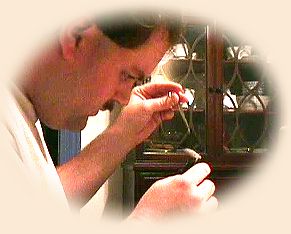For those that have followed my trip reports for this summer, I was fishing
the ponds I'd "found" in a local retirement community. The ones with the
BIG bass. I got to the water about 2 p.m. yesterday, expecting the high sun
and heat to have the fish down deep. This was not the case.
The water was extremely clear, and I could see numerous small (6 - 15") bass
sunning in the shallows, intermixed with bluegills, pumpkinseeds and green
sunnies. Patrolling the slightly shadowed depths were several large, dark
shapes, which caused significant scatter response in the sunfish holding in
the shallows. Having been frustrated by these bass before and with nothing
new to show them, I concentrated on the smaller fish in the shallows. I was
here to relax, after all.
I had on a white foam Comparadun that I've been using to fish the White Miller
hatch for smallmouth on the Susquehanna. Floats well, easy to see, and got
lapped up by the first bluegill that drifted up to it. Works for me! I fished up the
bank, catching several hand-sized bluegills and larger pumpkinseeds. The
bass had no interest in the surface fly, so I worked up towards the shallow
corner that generally holds a lot of large 'gills.
As I worked up the shoreline, I unhooked another bluegill and noticed a small
overhand wind knot in the 4 lb. tippet. It was far enough up that if I cut it, I'd have
to retie the whole tippet. It wasn't going to pick out. Ah well, the bluegill aren't
straining the line that much, and the bass are patrolling the far end of the pond.
I shot a cast out over deep water and after a couple of twitches, was rewarded
with the soft pop of a surface take.
I was soon to learn two very important lessons, and a third lesson would follow
later. Lesson 1, a bluegill in distress must make a lot of noise.
2, bass have good hearing. The small bluegill suddenly got very
heavy and started heading out to deep water. Having played this game before,
I tugged the rod a few times, to convince the bass to release the 'gill. He wasn't
too interested in letting go of his prize, so a couple more tugs and, pop! That
wasn't an "ok, I'll let go of the bluegill" pop. Sure enough, right at the wind knot.
Oh well.
Retied the tippet and noticed a small black zonker minnow that I had received in
a past swap. Black zonker strip, black Mylar tubing body, a little orange hackle
on the collar and some lead for weight. Hmm. First cast and one of the smaller
bass came rocketing out of the shallows as the minnow twitched down the shoreline.
Bam! Hook up! Some splashing, dogging and jumping later and I unhooked the 12"
bass. A couple more casts targeted at bass holding the shallows yielded similar
results. I started hunting the bigger shadows. I got interest, but no commitments.
I'm thinking now. Olive zonker, pearl Mylar, a little blue at the collar...maybe. But,
that'll have to be tied later, right now, there are fish to be caught.
I work a lap of the pond picking off the occasional bass, and interesting the bigger
bluegill. I switch over to a #8 streamer nymph. Tan marabou tail, brown Antron body
with copper rib, silver KFlash wing and an orange thread head. The bluegill are
more than happy to take advantage of the twitching streamer and make a meal of it.
One hook up surges away from shore then suddenly goes slack. As I strip in line to
gather for another cast, I see the bluegill bee lining for shore, fly still in it's mouth.
The bass shoots in behind it, pushing water in all directions before taking a sharp
turn away from the shallow rocks. A second bass is with it, the two working in tandem
to herd bluegill along the banks. The one bass looks like the one that my brother
caught about a month ago on a plastic jerkbait. Fish was probably 4-5 pounds.
The other bass is noticeably bigger.
As they proceed to harass other bluegill that I hook, I get a better look at them.
The larger of the two has a scar running vertically from his lip up towards his head,
about a half-inch long. And then, on one full barrel charge they make towards
shore, I get a good look at the two of them and the sinking realization sets in.
That's not a scar. It's my #12 white foam Comparadun!! I had the bass hooked
clean and lost it to not wanting to retie my tippet.
Can we say lesson #3, boys and girls?
I manage to assuage my aggravation with a couple of dozen additional fair
sized bluegill before the time and temperature suggest that it's time for me
to get home.
White foam Comparadun
Hook: #12 Mustad dry, barbless.
Thread: 6/0 Danville's White.
Tail: White deer hair.
Body: White closed cell foam.
Wing: White deer hair.
- Tie in thread and wrap to barb. Tie in long tail of 4-6 hairs.
- Wrap to 2/3 point on hook and tie in small clump of deer hair, fan wing.
- Tie in foam behind wing, excess pointed back over the bend of the hook.
Wrap thread to barb of hook and then wrap forward, binding foam smoothly
to hook shank.
- Pull foam to the side and then begin wrapping forward. Start with good tension,
relaxing as the foam advances. This will build a natural taper into the body shape.
Wrap forward of wing and tie off.
For fishing White Millers, use a black waterproof marker to put a small band at the
thorax, under the wing. ~ Jason
|



